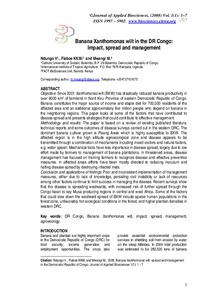| dc.contributor.author | Ndungo, V. |
| dc.contributor.author | Fiaboe, K.K.M. |
| dc.contributor.author | Mwangi, M. |
| dc.date.accessioned | 2019-12-04T11:14:31Z |
| dc.date.available | 2019-12-04T11:14:31Z |
| dc.date.issued | 2008 |
| dc.identifier.citation | Ndungo, V., Fiaboe, K. & Mwangi, M. (2008). Banana Xanthomonas wilt in the DR Congo: impact, spread and management. Journal of Applied Biosciences, 1(1), 1-7. |
| dc.identifier.issn | 1997-5902 |
| dc.identifier.uri | https://hdl.handle.net/20.500.12478/2783 |
| dc.description.abstract | Objective: Since 2001 Xanthomonas wilt (BXW) has drastically reduced banana productivity in
over 8000 km2 of farmland in Nord Kivu Province of eastern Democratic Republic of Congo.
Banana constitutes the major source of income and staple diet for 700,000 residents of the
affected area and an additional approximately five million people who depend on banana in
the neighboring regions. This paper looks at some of the factors that have contributed to
disease spread and presents strategies that could contribute to effective management.
Methodology and results: The paper is based on a review of existing published literature,
technical reports and some outcomes of disease surveys carried out in the eastern DRC. The
dominant banana cultivar grown is Pisang Awak which is highly susceptible to BXW. The
affected region is in the high altitude agroecological zone and disease appears to be
transmitted through a combination of mechanisms including insect vectors and natural factors,
e.g. water splash. Mechanical tools have less importance in disease spread, largely due to low
effort made by farmers to management of banana plantations. In threatened areas, disease
management has focused on training farmers to recognize disease and effective preventive
measures. In affected areas efforts have been mostly directed to reducing inoculum and
halting disease spread by destroying infected mats.
Conclusion and applications of findings: Poor and inconsistent implementation of management
measures, either due to lack of knowledge, persisting civil instability or lack of resources
among other factors continue to limit success in managing the disease. Recent surveys show
that the disease is spreading westwards, with increased risk of further spread through the
Congo basin to key Musa producing regions in central and west Africa. Some of the factors
that could slow down the westward spread of BXW include sparse human populations in the
forest zone, unfavorably hot ecological conditions in the forest, and higher plantain densities in western DRC. |
| dc.language.iso | en |
| dc.subject | Banana Xanthomonas Wilt |
| dc.subject | Impact Spread |
| dc.subject | Management |
| dc.subject | Agroecology |
| dc.subject | Xanthomonas Infections |
| dc.subject | Food Security |
| dc.title | Banana Xanthomonas wilt in the DR Congo: impact, spread and management |
| dc.type | Journal Article |
| dc.description.version | Peer Review |
| cg.contributor.affiliation | Catholic University of Graben |
| cg.contributor.affiliation | International Institute of Tropical Agriculture |
| cg.contributor.affiliation | FaCT BioSciences Ltd, Kenya |
| cg.coverage.region | Africa |
| cg.coverage.region | Central Africa |
| cg.coverage.region | East Africa |
| cg.coverage.country | Congo, Dr |
| cg.coverage.country | Uganda |
| cg.coverage.country | Kenya |
| cg.authorship.types | CGIAR and developing country institute |
| cg.iitasubject | Banana |
| cg.iitasubject | Agribusiness |
| cg.iitasubject | Disease Control |
| cg.iitasubject | Farm Management |
| cg.iitasubject | Food Security |
| cg.iitasubject | Handling, Transport, Storage And Protection Of Agricultural Products |
| cg.iitasubject | Pests Of Plants |
| cg.iitasubject | Plant Diseases |
| cg.iitasubject | Plantain |
| cg.iitasubject | Plant Production |
| cg.accessibilitystatus | Limited Access |
| local.dspaceid | 93884 |

